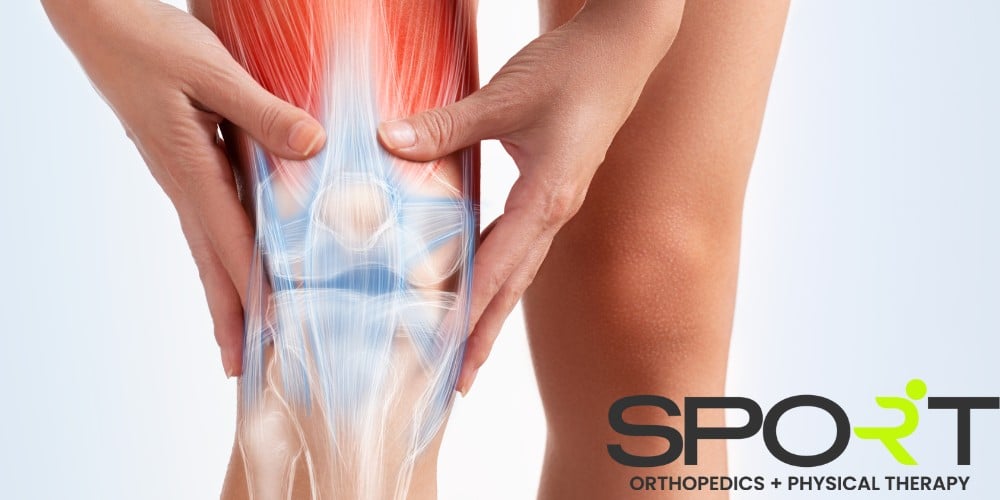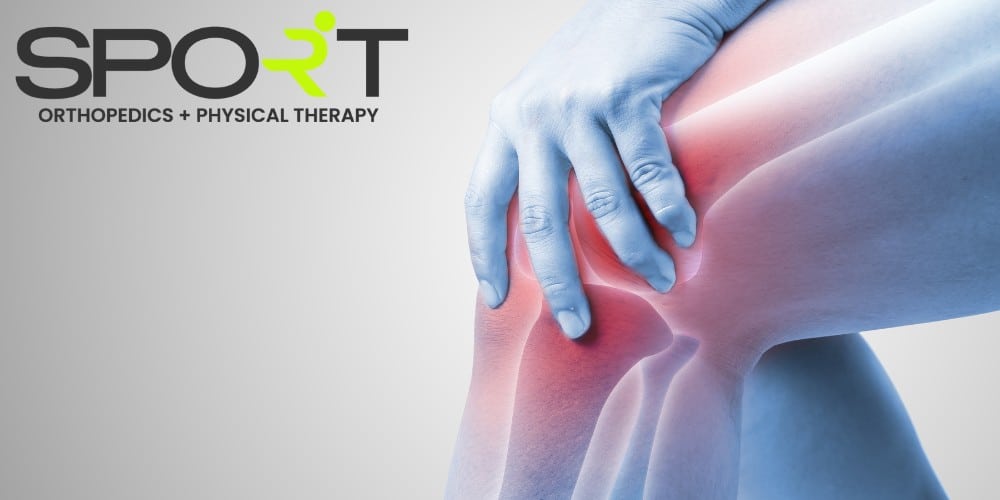
As with all surgeries, recovery time can vary depending on the patient, type of surgery, type of damage repaired, and their physical and mental condition. Most patients won’t have pain after the first few months after knee replacement surgery. It can take up to 2-3 months to return to most activities of daily living and 6 months to one year before your knee is strong and resilient and you begin to forget you had a knee replacement. For the best possible experience with your joint replacement, contact SPORT Orthopedics + Physical Therapy at 469-200-2832 today.

Knee joints are large hinge joints that connect the thigh bone (femur) with the shinbone (tibia). There is also a smaller bone that runs beside the shinbone and the kneecap at the front of your knee. Ligaments surround these bones, keeping the knee steady, connecting bones to each other, and then tendons attach the muscles to the bones.
There are two cushions made of cartilage where the tibia and femur meet, these are called the medial and lateral meniscus. They are shaped like a “C” and provide shock absorption, keeping the two bones from rubbing together. Bursae are also found within the joint. They are sacs that provide lubrication for movement.
Both a total knee replacement and a partial knee replacement are surgical procedures performed by an orthopedic surgeon to replace damaged bony surface and cartilage, or the cushion between your joints.
Total knee replacement surgery is when all the damaged bone and cartilage of the knee is replaced with metal or plastic components. This surgery can help ease the pain and make the knee function better. Patients that suffer from knee arthritis or a severe knee injury are most commonly considered for this procedure.
Partial knee replacement surgery normally lasts about one hour and is performed under spinal, epidural, or general anesthesia. Only the damaged portion of the knee is replaced during this procedure. A partial knee replacement is a minimally invasive procedure that is an alternative option for those who have damage to the knee in just a single limited area.
The recovery period after knee replacement surgery is crucial to the success of your procedure. You will typically be in the hospital for one night and some even go home the same day. You’ll be busy getting rest, taking care of your knee, and beginning physical therapy. It’s best to prepare your home well before surgery.
Right after surgery is when your rehabilitation begins. The day of surgery, you will have the help of a Dallas physical therapist to stand up and walk using an assistive device, such as a walker, cane, or crutches. You will have help from a nurse or occupational therapist to change bandages, dressing, bathing, and using the bathroom. The physical therapist will show you how to get in and out of bed and how to move around using the assistive device. They might ask you to sit at the side of the bed, walk a few steps, and then transfer yourself to the bedside commode.
The day after surgery, you may walk for brief periods of time using the assistive device. Your activity level will increase gradually as you recover from surgery. You can shower the day after surgery if our surgical team used waterproof dressings. If waterproof dressings were not used, you will have to wait for 5-7 days before showering and avoid soaking the incision for 3-4 weeks so that it fully heals. Your physical therapist may ask you to try to climb a few steps at a time. At this stage, you will need to work on achieving full knee extension.
Your surgery’s success will depend on how well you follow your surgeon’s instructions at home during the first few weeks following surgery.
You should be able to move around more freely and experience less pain. Your daily routine should include the exercises that your physical therapist has given you. Walking and standing for 10 minutes or more, bathing, and dressing should be easier. Your knee may actually be strong enough to not need your walker anymore. People progress to a cane or no assistive device at all by 2-3 weeks.
You should notice a dramatic improvement in your knee if you’ve stayed on your physical therapy exercises and rehabilitation schedule. Swelling and inflammation should also be reduced by now. Increasing your knee strength and range of motion is the goal at this point of your recovery. Some people may start driving within this period, but it is best to consult your doctor beforehand. Traveling before 6 weeks post surgery can increase your risk of a blood clot due to prolonged sitting, so it is best to wait until after 6 weeks. If you can not wait to travel, your doctor may recommend blood thinners be used.
Physical therapy will continue for about 12 weeks after your surgery. Your physical therapist will most likely modify your exercises as your knee improves. These may include, but are not limited to bicycling on a stationary bike, toe and heel raises, mini squats, hip abductions, leg balances, and step-ups. This time of your recovery is very important! Commiting to your rehabilitation will determine how fast you can return to your normal lifestyle. The pain and stiffness should be significantly reduced and you may be able to walk without an assistive device for a couple of blocks.
At 12 weeks, you will still need to do your exercises but also avoid high impact activities to avoid damaging your knee or the tissues that surround it. Many patients are beginning to enjoy activities such as golf, dancing, and bicycling. Your pain may be minimal or gone completely at this point.

Your physical therapist will teach you exercises to target your specific limitations. We know that it can be difficult to get your knee moving after surgery, however it is very important. The two most common exercises prescribed are quad sets and heel slides. These exercises work on straightening and bending your knee, and are crucial to a full recovery.
While knee surgeries are major operations, they are some of the safest and most common surgeries performed. Your knee surgery should be successful if you stick to your careful planning and commitment to instructions. You will be back to doing the activities you love in no time.
SPORT Orthopedics + Physical Therapy will see you through your operation and rehabilitation time. We will help you regain function and strength in your knee by reducing pain and increasing mobility and flexibility. We have two offices to serve you with the best care in Dallas and Frisco. To schedule an appointment, call (469) 200-2832.












*We accept most all insurance plans, if you do not see your plan listed above or have any questions, please contact our office.

SPORT Orthopedics + Physical
Therapy – Dallas, TX
Services:
• Clinic • Orthopedic • Urgent Care
• Physical Therapy
18152 Preston Road
Suite I-2
Dallas, TX 75252
Phone: (469) 200-2832
Fax: (469) 269-1074
SPORT Orthopedics + Physical Therapy – Frisco, TX
Services:
• Clinic • Orthopedic • Urgent Care
• Physical Therapy
9255 Dallas Parkway
Suite I20
Frisco, TX 75033
Phone: (469) 200-2832
Fax: (469) 269-1074
SPORT Orthopedics + Physical
Therapy – Wylie, TX
Services:
• Clinic • Orthopedic • Urgent Care
• Physical Therapy
3400 FM 544
Suite 650
Wylie, TX 75098
Phone: (469) 200-2832
Fax: (469) 269-1074
SPORT Physical
Therapy – Prosper, TX
Services:
• Physical Therapy
790 N Preston Rd
Suite 60
Prosper, TX 75078
Phone: (469) 850-0201
Fax: (469) 269-1074
SPORT Orthopedics – Mesquite, TX
Services:
• Clinic
• Orthopedic
• Urgent Care
1102 North Galloway Ave
Mesquite, TX 75149
Phone: (469) 200-2832
Fax: (469) 269-1074